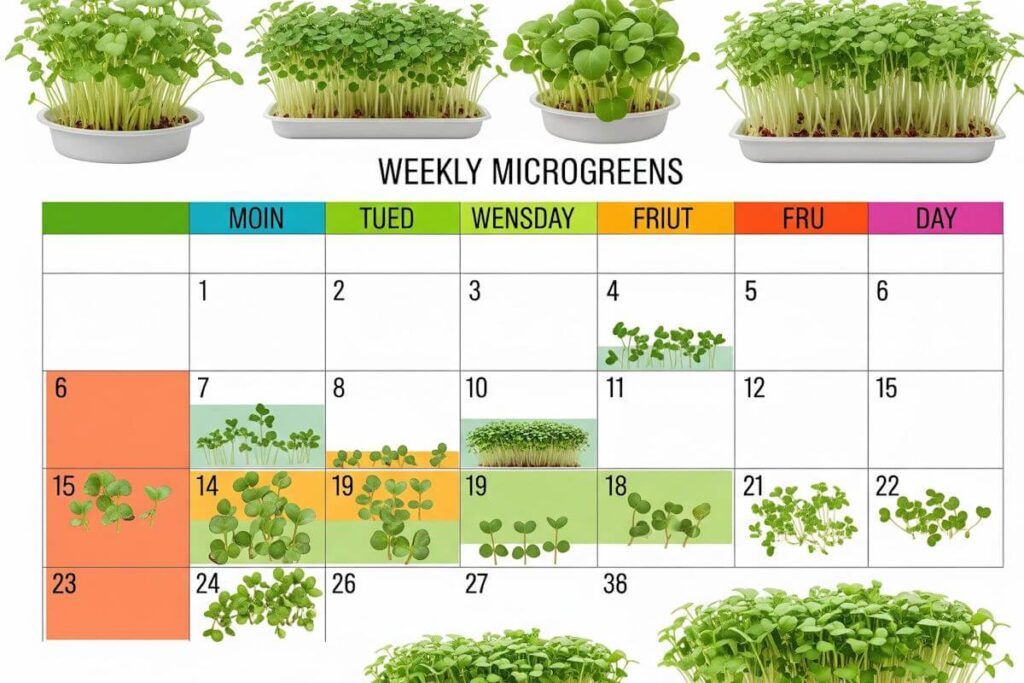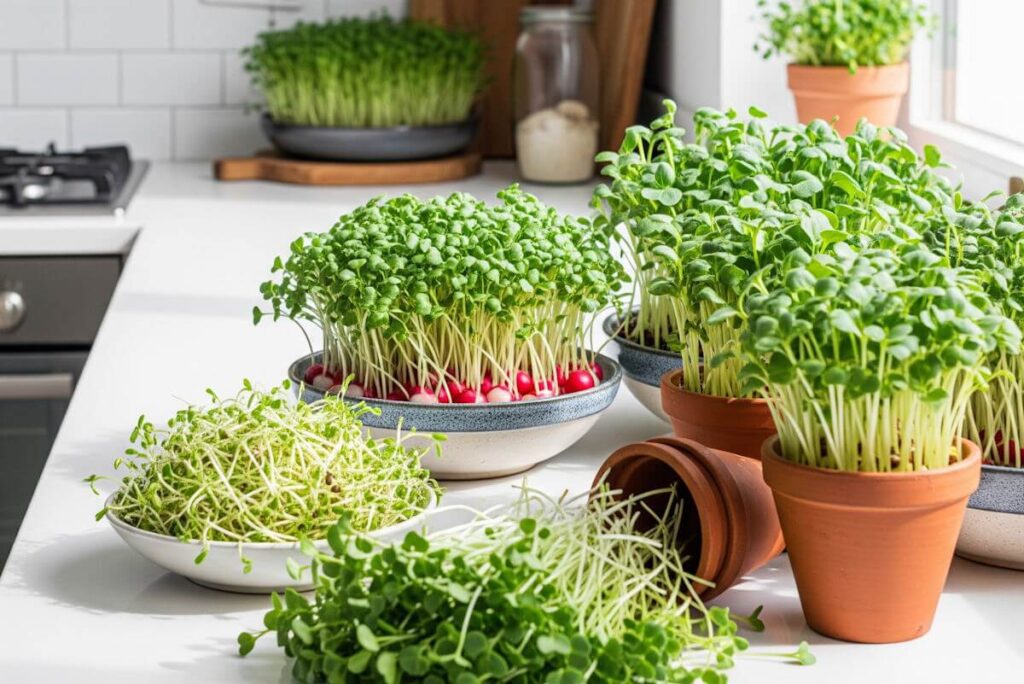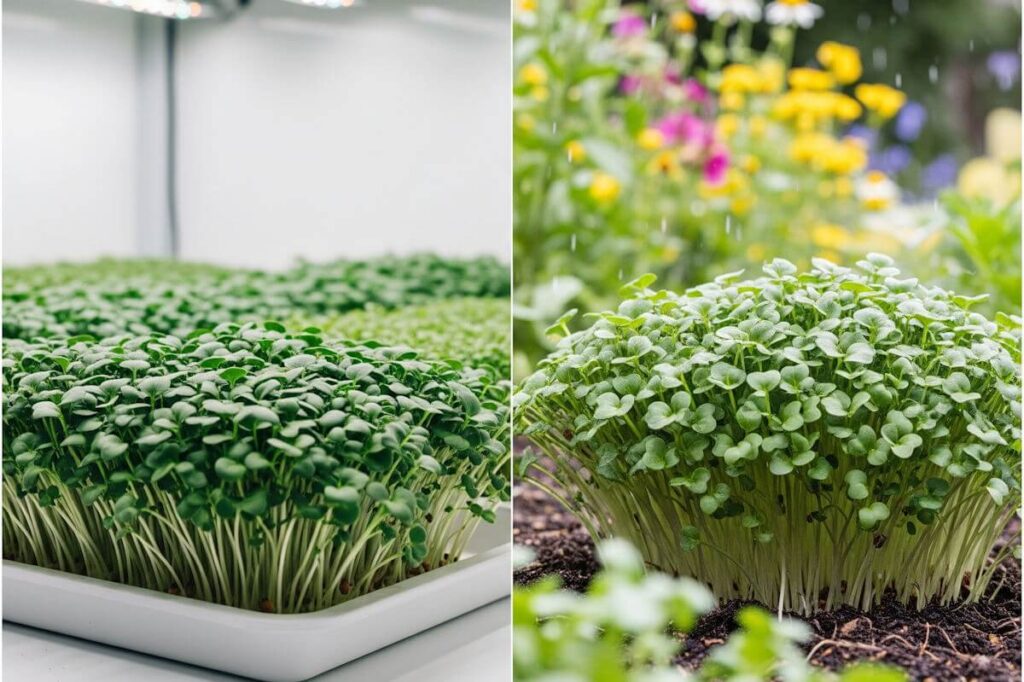Microgreens are young, edible plants harvested shortly after the first true leaves have developed. They come from a wide range of plant families, including vegetables, herbs, and even some grains. Generally, microgreens are harvested around 7 to 21 days after germination, providing a concentrated source of flavor, nutrition, and vibrant color. These tiny greens have grown increasingly popular in culinary practices for their unique textures and bold flavors, making them an ideal ingredient in salads, sandwiches, and garnishes.
The nutritional benefits of microgreens are significant. Research has shown that microgreens often contain higher nutrient levels compared to their mature counterparts. They are particularly rich in vitamins C, E, and K, as well as various antioxidants. These potent nutrients support overall health and may contribute to improved immune functions, enhanced skin health, and reduced risk of chronic diseases. As a result, incorporating microgreens into one’s diet can be an easy way to boost nutritional intake.
There are several reasons why home gardeners are turning to microgreens as a favored option. For one, they require minimal space, making them accessible for those with limited gardening abilities or small living areas. A windowsill or small countertop can serve as an effective growing location for microgreens. Additionally, the quick turnaround time from seed to harvest allows gardeners to enjoy their produce within weeks, reinforcing the satisfaction of gardening while yielding fresh, nutritious greens.
In an era where health-conscious eating is on the rise, and sustainability is prioritized, microgreens undeniably offer numerous advantages, making them an attractive choice for both novice home gardeners and culinary professionals alike. Their versatility and ease of cultivation further cement their place in modern kitchens and gardens.
Understanding Growth Cycles
The growth cycles of microgreens play a fundamental role in establishing an effective weekly harvest schedule. Microgreens, which are young seedlings of edible vegetables and herbs, vary widely in their germination times, optimal growing conditions, and life spans. Understanding these growth traits is essential for ensuring a steady supply of fresh greens.
Typically, the germination period for microgreens ranges from 3 to 14 days, depending on the species. For instance, varieties like arugula and radish are known for their quick germination, often sprouting in just 5 to 7 days. On the other hand, slower-growing types such as basil or cilantro might take closer to 10 to 14 days to emerge. It is important to note that during this germination phase, appropriate temperature, moisture, and light conditions are crucial. Ideally, microgreens thrive in temperatures between 65°F and 75°F, with consistent moisture levels to promote rapid sprouting.
Once germination occurs, microgreens typically continue growing for an additional 7 to 21 days until they are ready for harvest. Their life span can vary based on factors such as light exposure and nutrient availability. For example, sunflowers and peas may reach their optimal harvest stage in approximately 7 to 10 days, while more delicate varieties like mustards or cresses can be harvested in as little as 10 days. Thus, maintaining consistent light and providing adequate nutrients will encourage healthy growth across all microgreens.
In summary, understanding the specific growth cycles of various microgreens is crucial for anyone looking to develop a reliable harvest schedule. By considering germination times, optimal growing conditions, and the general life spans of different varieties, growers can effectively plan for a continuous and abundant supply of fresh microgreens throughout the growing season.
Setting Your Harvest Goals
Establishing clear harvest goals is a vital step in developing a consistent weekly microgreens harvest schedule. Understanding your consumption needs and target markets is essential in determining the quantity and types of microgreens you should cultivate. First, assess how much microgreens you or your intended clientele consume on a regular basis. This evaluation will help inform the scale and frequency of your harvests.
If you are growing microgreens for personal use, consider your dietary preferences and the variety of microgreens you enjoy the most. Popular options, such as sunflower, pea shoots, and radish microgreens, offer different flavors and nutritional benefits. On the other hand, if you are providing for a restaurant or a farmer’s market, research customer preferences and current market trends to ascertain which varieties are in demand. Tailoring your harvest goals according to consumer insights can enhance your success significantly.
Moreover, it is crucial to establish whether you will be supplying microgreens on a regular basis or in sporadic bursts. For instance, if you are catering to a local restaurant, understand their menu rotation and the frequency they require fresh microgreens. In contrast, supplying a farmer’s market may call for a different harvesting schedule, as you will need to account for peak customer traffic on market days.
In addition to understanding consumption patterns, it is advisable to maintain a record of your previous harvests. This documentation assists in refining your goals over time, allowing you to assess the effectiveness of your efforts and make informed adjustments. Set SMART (Specific, Measurable, Achievable, Relevant, Time-bound) goals tailored to your needs, ensuring that you can develop a harvest schedule that aligns with those objectives.
Creating a Planting Schedule
Developing a planting schedule is crucial for achieving consistent microgreens harvests. By aligning your planting activities with your harvest goals, you can ensure a continuous supply of fresh microgreens. The first step in this process is to determine your desired harvest frequency. Common intervals range from every few days to weekly, depending on your needs and preferences.
Once you have established your harvest frequency, the next step is to identify which microgreens you would like to grow. Different varieties can have varying growth cycles, which is an important factor to consider in your schedule. For instance, radish microgreens typically reach maturity within 5 to 10 days, while basil microgreens may take 14 to 20 days. It is essential to research the specific growth cycles of your chosen microgreens to appropriately space your plantings.
After determining your varieties and their growth cycles, create a timeline that reflects both your planting and harvesting days. For instance, if you plan to harvest on a specific day each week, count backward based on the maturity of each microgreen type to time your plantings effectively. It is advisable to stagger your planting dates, allowing for consistent harvests without overwhelming yourself or having an excess of microgreens at any one time.
To visualize your planting schedule, consider using a calendar or planner. Mark the specific dates for planting and anticipated harvesting, ensuring that you space out plantings to match the growth rates of each variety. This structured approach not only optimizes your microgreens production but also helps maintain a consistent workflow in your gardening routine.
Incorporating this planting strategy will enhance your ability to meet your harvest goals and provide a reliable source of fresh microgreens throughout the growing season.
Tools and Supplies Needed
To successfully grow microgreens, it is essential to have the right tools and supplies that facilitate a smooth harvesting process. The primary requirement is a set of growing trays. These trays are specially designed for microgreens, typically featuring drainage holes to prevent overwatering. Selecting the appropriate size depends largely on the space you have available and the quantity of microgreens you wish to grow.
Next, high-quality soil is crucial for nourishing your microgreens. A lightweight, soilless mix is often preferred, as it allows for excellent drainage and root development. Look for mixes that are rich in organic matter and free from fertilizers and chemicals that could affect the taste or safety of the final crop. The quality of seeds is equally important; thus, sourcing seeds from reputable suppliers will ensure greater germination rates and healthier plants. Varieties such as radish, sunflower, and pea tend to be popular choices among growers.
Watering systems also play a pivotal role in maintaining an optimal environment for your microgreens. A fine mist spray bottle is a common choice for beginners, allowing for gentle watering without displacing tiny seeds. More experienced growers often invest in automatic watering systems, which can help maintain consistent moisture levels without the need for manual intervention.
Beyond the essentials, optional tools can enhance your overall microgreens cultivation experience. Items such as grow lights can support growth in spaces with insufficient natural light, while pH testing kits can be used to monitor soil pH, ensuring that conditions remain ideal for growth. By carefully selecting these tools and supplies, you can establish a productive microgreens harvesting schedule with ease and efficiency.
Maintaining Ideal Growing Conditions
Creating optimal growing conditions is essential for cultivating microgreens successfully. These young plants thrive under specific environmental factors, which can significantly affect their growth rate and health, ultimately influencing your harvest schedule. Light is one of the most important factors; microgreens require a consistent exposure to bright, indirect sunlight or a suitable grow light for 12 to 16 hours each day. When using artificial lighting, ensure that the bulbs are positioned about 12 to 24 inches above the plants to prevent excessive heat buildup and to maximize photosynthesis.
Temperature also plays a critical role in the growth of microgreens. The ideal range is typically between 60°F to 75°F (15°C to 24°C). It is crucial to avoid extremes, as high temperatures can lead to rapid growth, resulting in spindly plants, while low temperatures can stunt development. Installing a thermostat or using heat mats during colder months can help maintain the necessary warmth for preferred growth.
Humidity levels should be monitored closely, as microgreens grow best in a humid environment, ideally around 40% to 60% relative humidity. A lack of humidity can lead to wilting, whereas excessive moisture may encourage mold growth. Using a humidity dome or a mini greenhouse can retain moisture without overly saturating the soil. Adequate ventilation is essential as well; fresh air circulation minimizes the risk of mold and pests. An oscillating fan can help maintain airflow, particularly in confined spaces.
Establishing consistent care for these environmental factors not only aids in producing healthy microgreens but also aligns with a reliable harvest schedule. By creating and maintaining ideal conditions, you will enhance the quality and yield of any microgreens you cultivate.
Scheduling Watering and Care
Creating a consistent watering and care schedule is pivotal to achieving a thriving microgreens harvest. Microgreens require specific attention to their watering needs, which typically vary based on the type of seeds used, the growing medium, and environmental conditions. Generally, it is recommended to water microgreens once or twice daily, depending on their maturity and moisture levels in the growing medium. Checking the surface of the soil or growing mat is essential; it should feel moist but not overly saturated. Overwatering can lead to mold and root rot, while underwatering can stunt growth and yield.
In addition to watering, regular care inspections should include monitoring for pests and diseases that could jeopardize the health of your microgreens. Early detection is crucial, as pests can quickly proliferate and interfere with growth. Establish a routine check every few days to inspect the leaves for any signs of pests such as aphids, spider mites, or whiteflies. Moreover, ensure that your growing space is clean and adequately ventilated to minimize the risk of pest infestations and fungal diseases.
Another necessary maintenance task involves managing the light exposure for your microgreens. Depending on the growing method—whether indoors under grow lights or outdoors in natural sunlight—ensuring they receive the appropriate amount of light is critical. Indoor microgreens typically require 12-16 hours of light daily. Conversely, outdoor varieties may need shade during the peak sun hours to prevent scorch. Align these care routines with your planned harvest schedule to guarantee your microgreens are robust and healthy when it is time to reap the benefits of your efforts.
Harvesting Techniques and Timing
Harvesting microgreens efficiently requires careful attention to timing and techniques that maximize flavor and nutritional value. Ideally, microgreens should be harvested when they reach their optimal size, typically within 10 to 25 days after germination, depending on the variety. Observing their growth and assessing their color and leaf development are vital indicators for the right harvest time.
To achieve peak flavor, consider harvesting microgreens just before they begin to flower. At this stage, they are at their most tender and nutrient-rich, providing enhanced taste and health benefits. Early morning is the best time to harvest, as the plants are likely to be hydrated and firm, reducing stress on the greens during the process.
Utilizing the proper tools is essential for an effective microgreens harvest. Sharp, clean scissors or a specialized microgreen harvester should be employed to cut the plants just above the soil line. This ensures minimal damage to both the plants and the roots, which can potentially grow again on another harvest cycle. Care should be taken to avoid tearing or crushing the delicate leaves, as this can lead to bruising and a decrease in quality.
Post-harvest handling of microgreens is critical to maintaining their freshness. After cutting, gently shake off any excess soil, but avoid rinsing them with water unless necessary, as moisture can hasten spoilage. Instead, use a soft brush if needed to remove dirt. Once cleaned, microgreens should be packaged in breathable containers to allow for air circulation, preventing moisture buildup. Employing proper storage methods, such as placing them in a refrigerator set at the right temperature, can extend their shelf life while preserving their vibrant color and crisp texture.
Adjusting Your Schedule for Success
Establishing a successful microgreens harvest schedule requires continuous evaluation and modification based on various factors. One of the primary reasons for adjusting your schedule is trial and error. As you gain experience with different varieties of microgreens, you may soon find that growth rates, yield sizes, and harvest times can vary significantly. Keeping a detailed log of each crop cycle can help you identify patterns and make informed decisions on adjusting timelines for future harvests.
Furthermore, changes in demand play a crucial role in determining the optimal harvesting schedule. Market preferences can shift due to seasonal trends, customer feedback, or even a sudden spike in interest for specific microgreens. Monitoring your sales trends and adapting your schedule accordingly will enable you to align your production with market needs. Engaging with regular customers or exploring social media for popular trends within the microgreens community can provide valuable insights for refining your harvesting plan.
Unexpected challenges, such as pest infestations or seed variability, are also important factors that may necessitate a revision of your harvest schedule. Pest issues can cause delays and impact quality, warranting a reassessment of your growing conditions and pest management strategies. In contrast, seed variability can lead to inconsistent germination rates, affecting your expected harvest timeline. In both scenarios, maintaining flexibility in your schedule allows you to pivot and implement corrective measures promptly to mitigate the impact on your growing experience.
Ultimately, integrating these considerations into your operational practices will improve not only your adaptability but also your overall success in cultivating microgreens. By embracing a mindset of continual assessment, you are setting the foundation for a thriving and efficient growing operation.




